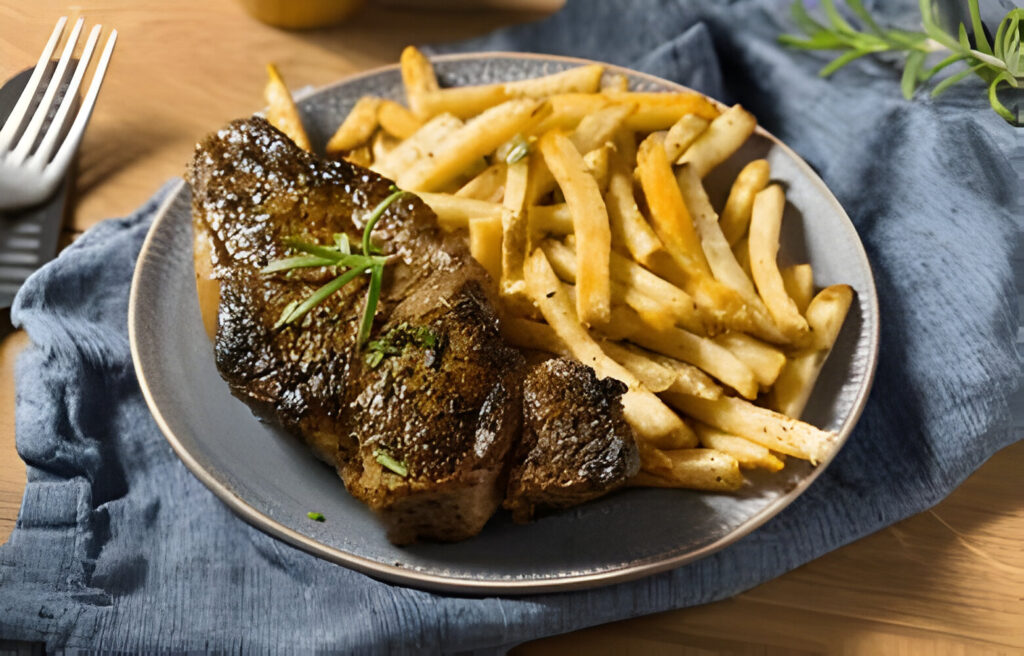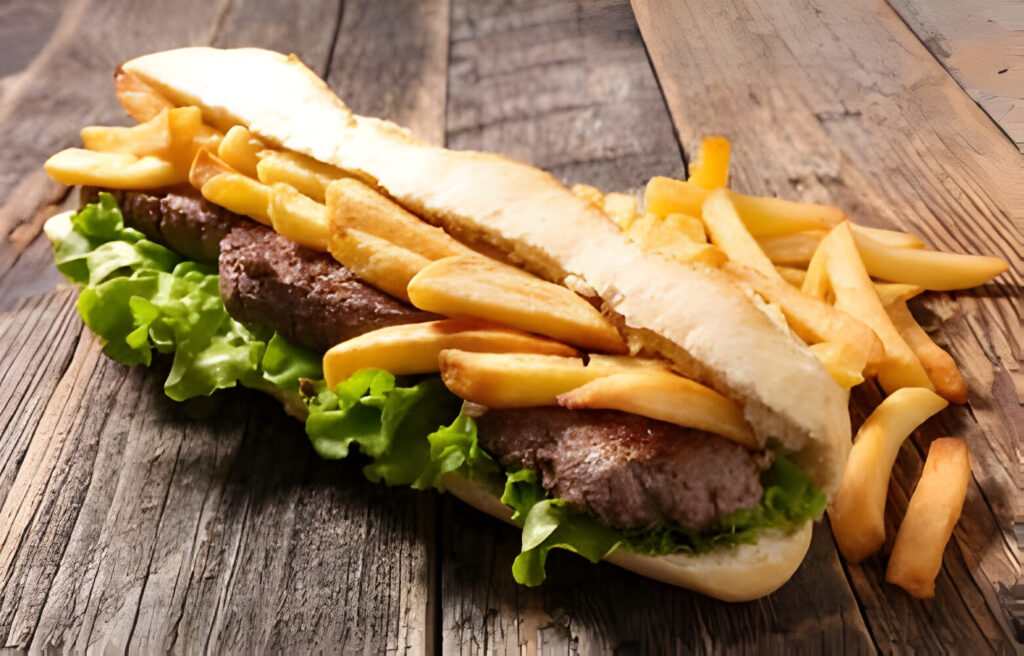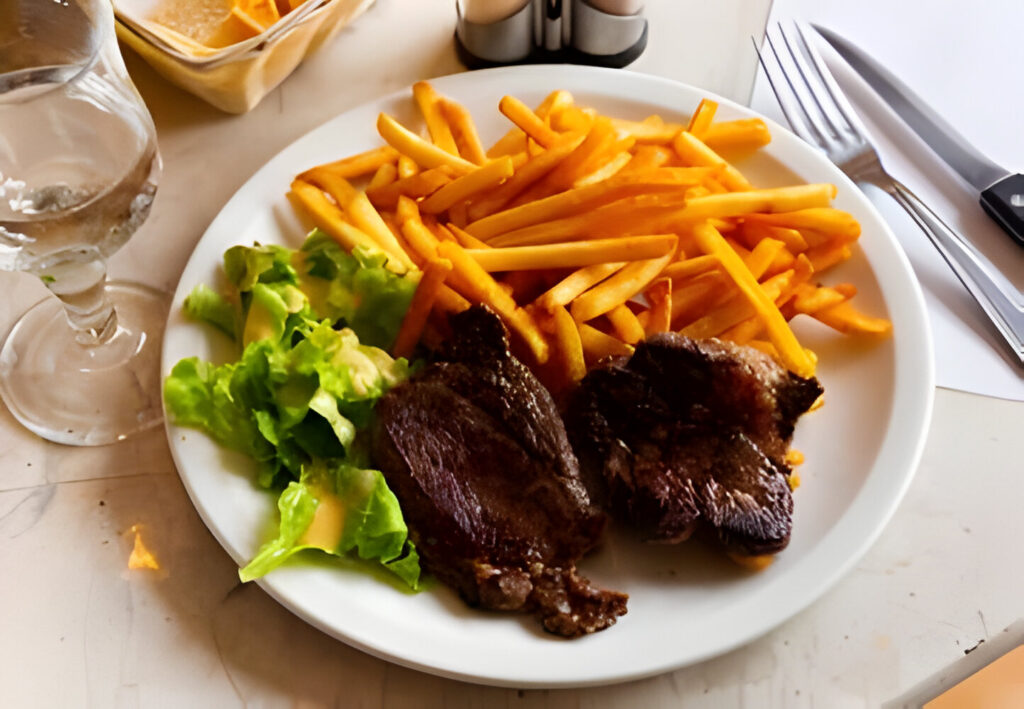
Introduction to Steak Frites
Steak Frites, a staple of French bistro cuisine, is a beloved dish around the globe. This culinary classic pairs perfectly cooked steak with crispy, golden fries. It epitomizes the elegance of simplicity in cooking. In this guide, we will walk you through the journey of creating the perfect Steak Frites at home, from selecting the right ingredients to mastering the cooking techniques.
The Origins of Steak Frites
Steak Frites, translating simply to “steak and fries,” has roots deeply embedded in French culinary tradition. While its exact origin remains a subject of debate, its widespread popularity across French bistros and restaurants is undeniable. This dish’s appeal lies in its simplicity, showcasing how two basic components can harmonize to create a comforting yet sophisticated meal. Understanding its history enriches the cooking process, connecting you to the culinary traditions that have shaped this beloved dish.
Global Appeal
Beyond France, Steak Frites has captured the hearts of food enthusiasts worldwide. Its universal appeal stems from the universal love for steak and potatoes, ingredients found in various cuisines. What sets Steak Frites apart is the perfection in preparation – a well-seasoned steak cooked to your preferred level of doneness and fries cut and fried to achieve the ideal balance of crunchiness and softness. This dish has been adapted and embraced by many cultures, reflecting the global palate’s appreciation for hearty, flavorsome meals.
What You Will Learn
In this guide, we aim to equip you with all you need to know to prepare Steak Frites at home. You will learn about:
- Selecting the right type of steak and potatoes.
- Preparing and seasoning your steak for optimal flavor.
- Techniques for frying potatoes to achieve perfect crispiness.
- Pairing sauces and condiments to enhance your dish.
- Serving suggestions to present your Steak Frites beautifully.
By the end, you’ll not only master the art of making Steak Frites but also understand the nuances that elevate it from a simple meal to a culinary delight. So, let’s embark on this delicious journey together, transforming basic ingredients into an exquisite dining experience.
Selecting the Right Ingredients
Crafting the quintessential Steak Frites begins with choosing the finest ingredients. This decision can significantly influence the dish’s flavor and texture. Let’s dive into the essentials: the steak, the potatoes, and the oil for frying.
Best Steak for Frites
When it comes to Steak Frites, not all cuts make the cut. For a tender and flavorful experience, ribeye and sirloin stand out. These selections offer the perfect balance of fat and meat, crucial for a juicy, flavorful steak.
Ribeye: This cut is known for its marbling. Marbling refers to the fat interwoven within the muscle. It melts during cooking, imparting a rich flavor and tender texture. For those seeking a luxurious taste, ribeye is the go-to choice.
Sirloin: Leaner than ribeye, sirloin still delivers on flavor. It’s a versatile cut that fares well with various cooking methods. Its robust beefy taste complements the simplicity of frites.
Choosing between these depends on personal preference. Do you favor a buttery, melt-in-your-mouth steak? Or do you lean towards a firmer, meatier bite? Either way, quality is key. Opt for steaks from reputable sources, ensuring they’re fresh and properly aged.
Potato Varieties for Fries
The perfect frite is crispy on the outside and fluffy inside. Achieving this starts with selecting the right potato. Russet potatoes are the gold standard for fries. Their high starch content is the secret to achieving the desired texture.
Russet Potatoes: Known for their size and earthy flavor, russets have a rough skin and white flesh. Their starchiness makes them ideal for frying, resulting in frites that are golden and crisp.
Before frying, a crucial step is to cut the potatoes into even sticks. This ensures uniform cooking. Soaking them in cold water can remove excess starch, preventing them from sticking together during frying.
High-Quality Oil for Frying
The choice of oil can make or break your frites. High smoke point oils are essential. They withstand high temperatures without burning, ensuring your frites are perfectly crispy.
Peanut Oil: With a high smoke point, peanut oil is ideal for frying. It also imparts a subtle flavor that enhances the potatoes.
Canola Oil: A versatile alternative, canola oil is light in flavor. It allows the natural taste of the potatoes to shine through.
When frying, temperature control is crucial. The oil should be hot enough to seal the potato’s exterior quickly. This locks in the moisture, ensuring a crispy exterior and a soft interior.
In summary, the secret to an exceptional Steak Frites lies in the quality of its components. Select your steak with care, choosing a cut that matches your taste preferences. Opt for russet potatoes for their ideal frying properties. Choose a high smoke point oil to achieve that perfect golden crisp. With these ingredients, you’re well on your way to creating a memorable dish.
Preparing Your Steak
Mastering the steak is pivotal for the iconic Steak Frites dish. The preparation process, from seasoning to cooking, plays a critical role in flavor development. Let’s delve into how to prepare your steak for a delectable outcome.
Seasoning the Steak
Seasoning is the first step to unlocking the steak’s full potential. Simple yet impactful, the right seasoning can elevate the meat’s natural flavors.
Salt and Pepper: These are the staples of steak seasoning. Use coarse salt and freshly ground black pepper for the best results. They not only enhance flavor but also improve texture.
Timing is Key: Season your steak about 30 minutes before cooking. This allows the salt to penetrate and season the meat deeply. It also helps to draw out moisture, creating a perfect searing surface.
For an extra layer of flavor, consider adding garlic powder or fresh herbs like thyme or rosemary. These should complement, not overpower, the steak’s natural taste.
Cooking Steak Perfectly
The method you choose for cooking your steak significantly affects its texture and juiciness. Pan-searing and grilling are two popular techniques that promise delicious results.
Pan-Searing: This method ensures a crusty, caramelized exterior while keeping the inside tender. Heat a skillet over high heat and add a small amount of high smoke point oil. Once hot, sear the steak on each side until it reaches your desired doneness. For an added touch of luxury, baste the steak with butter and herbs in the final minutes of cooking.
Grilling: Ideal for adding a smoky flavor, grilling requires preheating your grill to high. Cook the steak over direct heat to form a charred exterior, then move to a cooler part of the grill to finish cooking to your preferred level of doneness.
Resting the Steak: An often overlooked yet crucial step is resting the steak after cooking. Allow it to sit for about 5 to 10 minutes before slicing. This process redistributes the juices, ensuring every bite is as succulent as the last.
Final Touches
Slicing the steak correctly is the final step in preparation. Cut against the grain to ensure tenderness. Thin, even slices not only present beautifully but also enhance the eating experience.
By following these detailed steps for seasoning, cooking, and resting your steak, you’re set to achieve a mouth-watering centerpiece for your Steak Frites dish. Remember, patience and attention to detail transform good steak into an extraordinary one.

Making Perfect Frites
Achieving the quintessential frites, the beloved counterpart to your steak, demands attention to detail. This section guides you through the process, from selecting potatoes to the final, satisfying crunch of perfectly fried frites.
Preparing Your Potatoes
Start with the right foundation: Russet potatoes. Their high starch content is key to achieving that coveted crispy exterior and fluffy interior.
Selecting and Cutting: Choose large, firm Russet potatoes for uniform frites. Cut them into even sticks, about ¼ inch thick, to ensure consistent cooking.
Soaking: Soak the cut potatoes in cold water for at least an hour, or overnight if possible. This step removes excess starch, preventing sticking and ensuring crispiness.
Drying: After soaking, dry the potatoes thoroughly with a clean kitchen towel. Any moisture on the surface can cause the oil to splatter, affecting the frying process.
The Double Frying Technique
Double frying is the secret to perfect frites. This method involves frying the potatoes twice at different temperatures.
First Fry: Heat your chosen oil (preferably peanut or canola for their high smoke points) to 325°F. Fry the potatoes in batches to avoid overcrowding. This first fry, lasting about 5-7 minutes, cooks them through without browning. Remove the frites and let them cool on a wire rack.
Second Fry: Increase the oil temperature to 375°F. Return the potatoes to the oil for their second fry. This step crisps the exterior while keeping the interior soft. Fry until they are golden brown, about 3-5 minutes.
Seasoning and Serving
Immediately after the second fry, season your frites. A sprinkle of fine sea salt is traditional, but feel free to add your twist with herbs or spices.
Serving: Serve your frites hot and crispy. They are best enjoyed fresh from the fryer, alongside your perfectly prepared steak.
In crafting the ideal frites, precision is key. From cutting to soaking, drying, and double frying, each step builds towards the ultimate goal: frites that are golden, crispy, and irresistibly delicious. Follow these steps, and elevate your Steak Frites to a culinary masterpiece.
Accompaniments and Variations
Enhancing your Steak Frites with the right accompaniments and embracing variations can transform this classic dish into a personalized culinary experience. Let’s explore the sauces that elevate the dish, serving suggestions to impress, and how to tweak the recipe for everyone to enjoy.
Classic Sauces and Condiments
The right sauce can elevate Steak Frites from good to unforgettable. Here are two timeless options:
Béarnaise Sauce: This tarragon-infused sauce is a classic. Its creamy texture and herbaceous flavor complement the richness of the steak beautifully. To make it at home, combine egg yolks, white wine vinegar, shallots, and fresh tarragon. The key is to whisk over gentle heat until the sauce thickens, then finish with a touch of butter for silky smoothness.
Aioli: For those who prefer a garlicky kick, aioli is a perfect choice. This Mediterranean sauce, made from garlic, egg yolks, and olive oil, offers a creamy texture and bold flavor. It pairs splendidly not just with the frites, but also with the steak, adding a zesty note to each bite.
Incorporating these sauces not only adds depth to the dish but also allows for personalization. Feel free to adjust the ingredients to suit your taste.
Serving Steak Frites
Presentation matters. Serve the steak and frites on a warm plate to maintain their perfect temperature. Place the steak alongside a generous portion of golden frites. Drizzle or dollop your chosen sauce tastefully on the side. Garnish with a sprinkle of coarse sea salt and a few fresh herbs for an added touch of elegance and flavor.
Recipe Variations
Steak Frites can be adapted to meet various dietary needs and preferences:
For Vegetarians: Replace the steak with a portobello mushroom cap. Marinate and grill for a meaty texture and rich flavor.
Gluten-Free Option: Ensure your fries are cooked in a dedicated fryer to avoid cross-contamination with gluten-containing foods.
Low-Carb Alternative: Substitute traditional frites with turnip or jicama fries. These vegetables offer a lower carb count but still deliver a satisfying crunch.
Embracing these variations ensures that everyone can enjoy a version of Steak Frites tailored to their dietary needs or preferences. Experiment with different sauces, sides, and replacements to find your perfect combination.
Conclusion and Final Tips
Mastering the art of Steak Frites at home brings a slice of classic French cuisine to your dining table. This guide aimed to equip you with the knowledge and skills needed to create a memorable dish. Let’s wrap up with some final tips and encourage you to take your culinary journey further.
Recap of Key Points
Remember, the secret to perfect Steak Frites lies in the quality of your ingredients and the care you put into each step. Choose the right cut of steak and the best variety of potatoes for frying. Pay attention to the oil’s temperature for crispy, golden frites, and don’t forget to rest your steak for optimal juiciness.
Professional Cooking Tips
- Temperature is Key: For steak, use a meat thermometer to ensure your desired doneness. For frites, maintain oil at the right temperature for frying.
- Season Generously: Salt brings out the flavors of both the steak and potatoes. Season at different stages for depth of flavor.
- Experiment with Sauces: While béarnaise and aioli are classics, exploring other sauces can add unique twists to your dish.
Serving Suggestions
Serve Steak Frites on a warm plate to keep everything hot. Arrange the steak and frites side by side, with the sauce elegantly on the side or drizzled over the steak. Garnish with fresh herbs for a pop of color and freshness.
Encouragement to Experiment
Cooking is an art and a science. Feel free to tweak this recipe to suit your tastes or to experiment with different ingredients. Whether it’s trying new cuts of meat, exploring a variety of potatoes, or crafting your sauce, each variation makes the dish uniquely yours.
Call to Action
We invite you to share your Steak Frites journey with us. Post your creations, tips, or variations in the comments below. Engaging with a community of fellow food enthusiasts can inspire and offer new insights into making Steak Frites an even more delightful experience.
Steak Frites embodies the joy of cooking and the pleasure of sharing good food. With these tips and encouragement, you’re well-equipped to bring this classic dish to life in your own kitchen. Bon appétit!

Frequently Asked Questions About Steak Frites
Preparing Steak Frites, a beloved dish in French cuisine, often comes with questions about its preparation, variations, and serving suggestions. We’ve compiled the most common FAQs to help you create the perfect Steak Frites at home.
What’s the Best Cut of Steak for Steak Frites?
The ideal cuts for Steak Frites are ribeye and sirloin. Ribeye, known for its marbling, provides a juicy and flavorful experience. Sirloin offers a leaner option without sacrificing taste. Both cuts ensure a tender and delicious steak when cooked properly.
How Can I Make My Frites Crispy?
To achieve crispy frites, start with russet potatoes due to their high starch content. Cut them evenly and soak in cold water to remove excess starch. Dry them thoroughly before frying. Use a high smoke point oil like peanut or canola, and double-fry the potatoes. First, fry at a lower temperature to cook through, then increase the heat and fry again to achieve golden, crispy perfection.
Are There Gluten-Free Options for Steak Frites?
Yes, making gluten-free Steak Frites is straightforward. The steak and potatoes are naturally gluten-free. However, ensure that any sauces or seasonings used do not contain gluten. For those with celiac disease or gluten sensitivity, it’s crucial to avoid cross-contamination during preparation.
Can I Prepare Steak Frites in Advance?
Steak Frites is best enjoyed fresh. However, you can prepare parts of the dish in advance. Frites can be cut and soaked ahead of time, and steak can be seasoned a few hours before cooking. For the best experience, cook both components just before serving to ensure the steak is juicy and the frites are crispy.
What Are Some Popular Sauces to Serve with Steak Frites?
Béarnaise sauce and aioli are classic choices that complement the dish wonderfully. Béarnaise, with its creamy texture and hint of tarragon, enhances the steak’s flavor. Aioli adds a garlicky punch, perfect for dipping frites. Feel free to explore other sauces, like peppercorn or mushroom, to find your preferred pairing.
How Do I Ensure My Steak Is Cooked to the Right Doneness?
Using a meat thermometer is the most reliable method to check for doneness. Here are the temperatures for each level of doneness: 120-125°F for rare, 130-135°F for medium-rare, 140-145°F for medium, 150-155°F for medium-well, and 160-165°F for well-done. Remember to let the steak rest for a few minutes after cooking to redistribute the juices.
Can Steak Frites Be Made Healthier?
To create a healthier version of Steak Frites, consider using a lean cut of steak like sirloin and trimming any visible fat. For the frites, baking instead of frying can reduce the oil content. Olive oil can be a healthier alternative for frying or roasting. Additionally, serving the dish with a side of fresh greens or vegetables can add nutritional value.
These FAQs aim to guide you through creating a delightful Steak Frites meal. By following these tips and techniques, you can bring a taste of French cuisine into your home kitchen, tailored to your dietary preferences and cooking style.
More from recipesmaya.com: